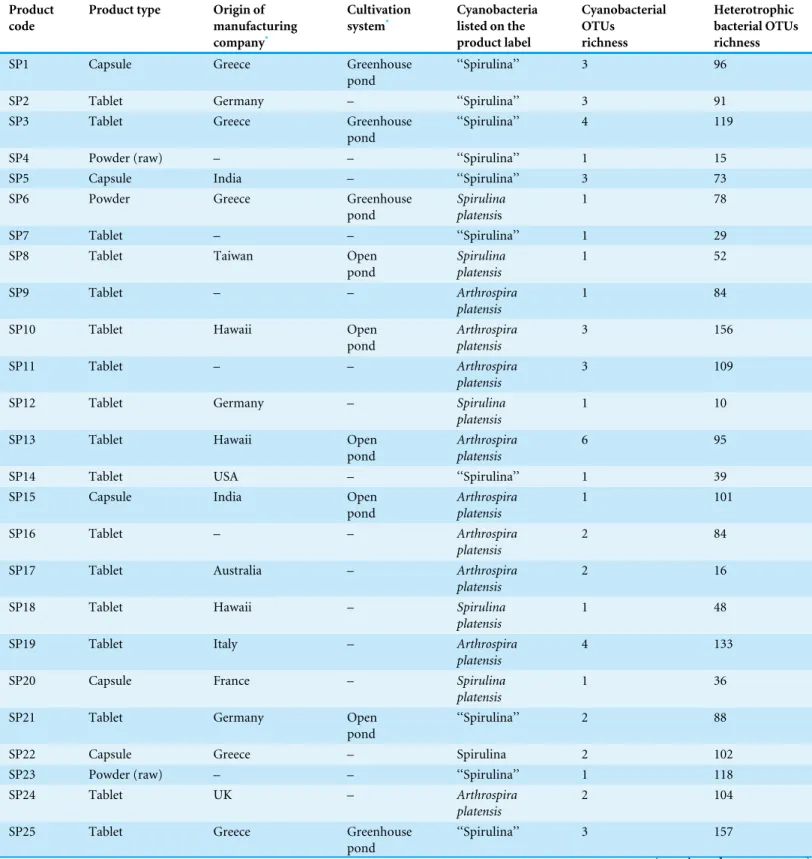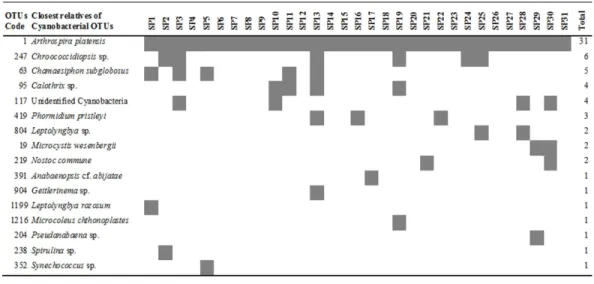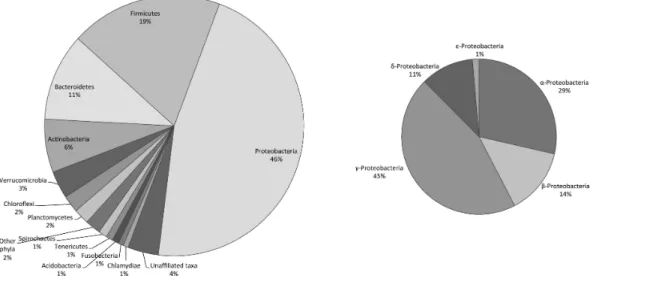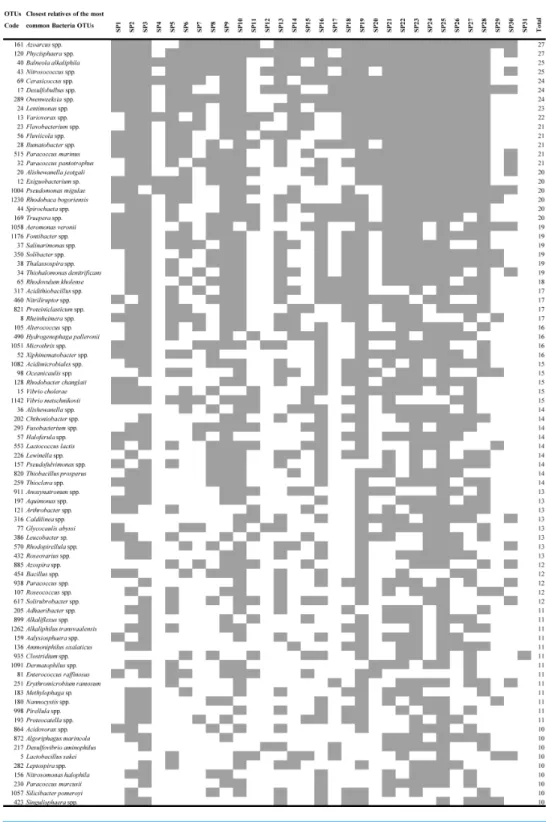Submitted20 October 2015 Accepted 29 December 2015 Published21 January 2016
Corresponding author Elisabeth Vardaka, evardaka@aqua.teithe.gr
Academic editor María Ángeles Esteban
Additional Information and Declarations can be found on page 11
DOI10.7717/peerj.1610
Copyright 2016 Vardaka et al.
Distributed under
Creative Commons CC-BY 4.0
OPEN ACCESS
Molecular diversity of bacteria in
commercially available ‘‘Spirulina’’ food
supplements
Elisabeth Vardaka1, Konstantinos A. Kormas2, Matina Katsiapi1,3, Savvas Genitsaris3and Maria Moustaka-Gouni3
1Department of Nutrition and Dietetics, Alexander Technological Educational Institute of Thessaloniki,
Thessaloniki, Greece
2Department of Ichthyology and Aquatic Environment, University of Thessaly, Volos, Greece 3School of Biology, Aristotle University of Thessaloniki, Thessaloniki, Greece
ABSTRACT
The cyanobacterium Arthrospirais among the most well-known food supplements worldwide known as ‘‘Spirulina.’’ While it is a widely recognized health-promoting natural product, there are no reports on the molecular diversity of commercially available brands of ‘‘Spirulina’’ supplements and the occurrence of other cyanobacterial and heterotrophic bacterial microorganisms in these products. In this study, 454-pyrosequencing analysis of the total bacterial occurrence in 31 brands of ‘‘Spirulina’’ dietary supplements from the Greek market was applied for the first time. In all samples, operational taxonomic units (OTUs) of Arthrospira platensiswere the predominant cyanobacteria. Some products contained additional cyanobacterial OTUs including a few known potentially toxic taxa. Moreover, 469 OTUs were detected in all 31 products collectively, with most of them being related to the Proteobacteria, Firmicutes, Bac-teroidetes, Actinobacteria and Verrucomicrobia. All samples included heterotrophic bacterial OTUs, ranging from 9–157 per product. Among the most common OTUs were ones closely related to taxa known for causing health issues (i.e.,Pseudomonas, Flavobacterium,Vibrio,Aeromonas,Clostridium,Bacillus,Fusobacterium,Enterococcus). The observed high cyanobacterial and heterotrophic bacterial OTUs richness in the final product is a point for further research on the growth and processing ofArthrospira biomass for commercial purposes.
SubjectsAgricultural Science, Aquaculture, Biodiversity, Food Science and Technology, Microbiology
Keywords Arthrospira,Spirulina, Food supplements, Cyanobacteria, Bacteria, Pyrosequencing
INTRODUCTION
Arthrospirais usually presented under the taxonomically incorrect nameSpirulina (Vonshak & Tomaselli, 2000). Since 1852, the classification of the genusSpirulina,based mainly on morphological features, has been a subject of long debate between taxonomists. In the last decades of the 20th century, new information have drastically changed the criteria that are used for the taxonomic classification of cyanobacteria (Castenholz, 1989;Komárek & Anagnostidis, 2005). According to the current polyphasic approach, which combines morphological, cytological, ecological, biochemical and molecular criteria, the genusSpirulinahas been re-evaluated, leading to the recognition of two separated genera,ArthrospiraandSpirulina(Komárek & Anagnostidis, 2005). Although, the nameArthrospirahas become universally accepted for the cultivated species, further clarification of their systematic position in the genusArthrospirais still ongoing.Komárek (2016), in his revision on the taxonomy and nomenclature ofArthrospiraspecies, has recommended the replacement of the commercial species nameArthrospira platensis, with the taxonomically-correct name ofArthrospira fusiformis. The complicated and still debated taxonomy ofArthrospiraand its relationship withSpirulinaraises serious concerns regarding the ‘‘identity’’ of traditionally edible cyanobacteria and as a conse-quence, regarding their nutritional quality (e.g., unlikeSpirulina,Arthrospiracontains the unsaturated fatty acidγ-linolenic acid) and the safety (e.g., unlikeSpirulina,Arthrospira
is known to be potential toxin producer) of their products (Ballot et al., 2004;Gantar & Svirčev, 2008;Lugomela, Pratap & Mgay, 2006;Vonshak & Tomaselli, 2000).
The growing consumers’ demand for cyanobacterial products as dietary supplements has offered the opportunity for rapidly growing commercial cultivation ofArthrospira all over the world. SinceArthrospirahas an optimum growth temperature in the range of 35–38◦C, large-scale cultivation is mainly located in tropical, sub-tropical and warm
temperate climate zones. Principal producers such as Earthrise Nutritionals in California and Cyanotech Corporation of Hawaii, USA; Hainan DIC Marketing in Hainan Island, China and Siam Algae Company in Bangkok, Thailand, produce together about 1,300 t (dw) ofArthrospiraannually (Gershwin & Belay, 2008). Today, China seems to be the most actively engaged country in cultivatingArthrospira, aiming to reach annual production to 106t (dw) (Lu, Xiang & Wen, 2011).
risk is much higher in natural environments, where the biomass harvested is essentially a mixture of multiple species of cyanobacteria and other microorganisms (Carmichael, Drapeau & Anderson, 2000). These challenges can be magnified as processes are scaled up (harvesting, drying and packaging) affecting the final quality of the product.
Although there is an existing threat concerning the involuntary inclusion of microbial contaminants in the dietary supplements, which may include potentially toxin-producing cyanobacteria or unwanted pathogens, to the best of our knowledge, no reports on the microbial content of such supplements have been published, based on sequencing methodologies. The present study serves as a ‘‘first step’’ to assess possible bacterial con-tamination of ‘‘Spirulina’’ supplements and consequently to allow for further studies and a stricter monitoring of these products. Thus, we applied 454-pyrosequencing analysis of the 16S rRNA gene in order to investigate whether commercially available brands of ‘‘Spirulina’’ supplements in the Greek market–with most of them having international commercial circulation- contain other prokaryotes in addition toSpirulina/Arthrospira, and to characterize prokaryotic phylotype richness of these products for the first time. Since these supplements are directly and largely consumed by the public, the presence of any non-target microorganism is of importance as a possible source of microbial contamination.
MATERIALS AND METHODS
Sample collection and handling
A total of 31 ‘‘Spirulina’’ dietary supplements of different brands were obtained from internet distributors, pharmacies and health food retail in Greece in 2013. Based upon the product labels and/or website information, most of the ‘‘Spirulina’’ products, originate from controlled cultures (open ponds) of different geographical origin (Europe, Asia, USA and Australia) and have international selling distribution network (Table 1). Four of the products come from greenhouse cultured ponds that operate in Greece. The most common species name referred in the labels of ‘‘Spirulina’’ dietary supplements is Arthrospira(Spirulina)platensis(16/31), while 15/31 products were labeled as containing ‘‘Spirulina.’’
‘‘Spirulina’’ samples were in the form of tablets (19/31), capsules (6/31), powders (3/31), candies (1/31), drops (1/31) and bar (1/31) (Table 1). Capsules were aseptically removed from the capsular form of samples before further analysis. Tablets, powders, candies and bar forms were homogenized aseptically using a mortar and pestle. Approxi-mately, 100 mg of each sample or a maximum of 10 drops was used for DNA extraction. Each sample for the DNA extraction consisted of a pooled triplicate sample. Three tablets/capsules/powder/candies from the same product batch were pooled together while for the liquid sample three bottles were mixed together before sampling the 10 drops.
Molecular analysis
Table 1 Commercially available ‘‘Spirulina’’ food supplements from the Greek market.OTUs: bacterial operational taxonomic units.
Product code
Product type Origin of
manufacturing company*
Cultivation system*
Cyanobacteria listed on the product label Cyanobacterial OTUs richness Heterotrophic bacterial OTUs richness
SP1 Capsule Greece Greenhouse
pond
‘‘Spirulina’’ 3 96
SP2 Tablet Germany – ‘‘Spirulina’’ 3 91
SP3 Tablet Greece Greenhouse
pond
‘‘Spirulina’’ 4 119
SP4 Powder (raw) – – ‘‘Spirulina’’ 1 15
SP5 Capsule India – ‘‘Spirulina’’ 3 73
SP6 Powder Greece Greenhouse
pond
Spirulina platensis
1 78
SP7 Tablet – – ‘‘Spirulina’’ 1 29
SP8 Tablet Taiwan Open
pond
Spirulina platensis
1 52
SP9 Tablet – – Arthrospira
platensis
1 84
SP10 Tablet Hawaii Open
pond
Arthrospira platensis
3 156
SP11 Tablet – – Arthrospira
platensis
3 109
SP12 Tablet Germany – Spirulina
platensis
1 10
SP13 Tablet Hawaii Open
pond
Arthrospira platensis
6 95
SP14 Tablet USA – ‘‘Spirulina’’ 1 39
SP15 Capsule India Open
pond
Arthrospira platensis
1 101
SP16 Tablet – – Arthrospira
platensis
2 84
SP17 Tablet Australia – Arthrospira
platensis
2 16
SP18 Tablet Hawaii – Spirulina
platensis
1 48
SP19 Tablet Italy – Arthrospira
platensis
4 133
SP20 Capsule France – Spirulina
platensis
1 36
SP21 Tablet Germany Open
pond
‘‘Spirulina’’ 2 88
SP22 Capsule Greece – Spirulina 2 102
SP23 Powder (raw) – – ‘‘Spirulina’’ 1 118
SP24 Tablet UK – Arthrospira
platensis
2 104
SP25 Tablet Greece Greenhouse
pond
‘‘Spirulina’’ 3 157
Table 1(continued)
Product code
Product type Origin of
manufacturing company*
Cultivation system*
Cyanobacteria listed on the product label Cyanobacterial OTUs richness Heterotrophic bacterial OTUs richness
SP26 Tablet – – Spirulina 1 76
SP27 Tablet Cuba Open
pond
Spirulina platensis
1 114
SP28 Capsule Australia – Spirulina
platensis
3 75
SP29 Drops Europe – ‘‘Spirulina’’ 3 37
SP30 Candies Europe – ‘‘Spirulina’’ 4 68
SP31 Bar Germany – ‘‘Spirulina’’ 1 9
Notes.
*Where (–), no information available.
detected in these analysis. Tag-pyrosequencing of the 16S rRNA gene was performed using PCR amplification of the V4-V6 region of the 16S rRNA gene and the primer pair S-DBact-0341-b-S-17 (5′-CCTACGGGNGGCWGCAG-3′) and S-D-Bact-0785-a-A-21
(5′-GACTACHVGGGTATCTAATCC-3′) for bacteria (Klindworth et al., 2013).
Sequencing was performed as described inDowd et al. (2008)in Roche 454 FLX titanium instruments and reagents after following manufacturer’s guidelines at the MRDNA Ltd. (Shallowater, TX, USA) sequencing facilities. Data processing and quality control were performed with the MOTHUR software (v 1.30) (Schloss et al., 2009) including denoising of the flowgrams using PyroNoise (Quince et al., 2009). Sequences with≥250 bp and no ambiguous or no homopolymers ≥8 bp were included for further analysis. These sequences were aligned using the SILVA SSU database (release 108,Pruesse et al., 2007). All sequences were binned into Operational Taxonomic Units (OTUs) and were clustered (average neighbor algorithm) at 97% sequence similarity (Kunin et al., 2010;Stackebrandt & Goebel, 1994). Taxonomic classification was based on the SILVA 108 database. The batch of sequences from this study has been submitted to the Short Reads Archive
(http://www.ncbi.nlm.nih.gov/sra) accession numberSRR2057094.
Statistical analysis
Since the heterotrophic bacterial OTUs richness was high in the 31 ‘‘Spirulina’’ dietary supplements samples, and the origin and handling process of each product were not obvious, the samples were grouped with cluster analysis (Sokal & Rohlf, 1981) using the Bray-Curtis similarity index in log transformed relative abundance values of the heterotrophic bacterial OTUs in order to investigate the differences between the samples attributed to these OTUs. The analysis was performed using the PAST software (Hammer, Harper & Ryan, 2001).
RESULTS AND DISCUSSION
Figure 1 Heatmap of occurrence of the operational taxonomic units (OTUs) that were closely related to cyanobacteria in commercially available ‘‘Spirulina’’ food supplements in the Greek market.
production line of the supplements. For this purpose, we applied 454-pyrosequencing analysis of cyanobacterial and total bacterial occurrence in these 31 products as one of the most inclusive tools in revealing the presence of known and yet-uncultivated bacteria. Although the limitations of the 454-pyrosequencing approach are well-known (e.g., limited primer universality (Hadziavdic et al., 2014), PCR amplification errors, nucleotide misincorporation, PCR chimera formation (Stoeck et al., 2010;Pawlowski et al., 2011), pyrosequencing errors (Kunin et al., 2010)), it can provide a complete picture of the diversity in such samples on the OTU level.
Cyanobacteria in “Spirulina” products
All of theArthrospira-related OTUs which were found in the commercially available ‘‘Spirulina’’ food supplements in the Greek market, were related only to Arthrospira platensis (Fig. 1), which was recently revised by Komárek (2016) as Arthrospira fusiformis. In each sample,A. platensis(A. fusiformis) was clearly the predominant taxon (81.2–100.0%) among the Cyanobacteria in all but the product SP29, in liquid form
(Table 1), in which Arthrospira spp. comprised only 48.6% and co-dominated with
Microcystis wesenbergii-related OTUs (48.3%).
Figure 2 Relative richness of the heterotrophic bacterial operational taxonomic units (OTUs) at the phylum level, found in commercially avail-able ‘‘Spirulina’’ food supplements in the Greek market.
chthonoplastes(1/31) andSpirulinasp. (1/31).Microcystis, NostocandAnabaenopsisspecies are known as potentially toxic producing cyanobacteria. Toxin production by cyanobacteria is species- and strain-specific and depends on environmental conditions (Sivonen & Jones, 1999), thus the presence of cyanotoxins cannot be predicted in this study.
Heterotrophic bacterial DNA in “Spirulina” products
In non-sterile large-scale cultivation systems of cyanobacteria, substances released from cells or decomposition of dead cells, provide a source of organic compounds for attracting heterotrophic bacteria (Becker, 1994). The genetic imprint of microbial DNA in the final ‘‘Spirulina’’ product may reflect the occurrence of bacteria in the different processing steps, i.e., culturing, harvesting, drying and packaging, of Arthrospiracommercial production facilities. In our study, the bacterial OTU richness associated with ‘‘Spirulina’’ food supplements was high. A total of 469 unique heterotrophic bacterial OTUs were found in the 31 products. The unique heterotrophic bacterial OTUs belonged to 20 different phyla, while 18 OTUs could not be affiliated to any of the known taxa. The majority of the OTUs were members of five phyla: Proteobacteria (46% of the total number of OTUs), Firmicutes (19%), Bacteroidetes (11%), Actinobacteria (6%) and Verrucomicrobia (3%). Within the most diverse phylum (Proteobacteria), the classes of γ- and α-Proteobacteria
dominated in terms of OTUs richness (45 and 29% of the Proteobacteria-related OTUs, respectively) (Fig. 2).
heterotrophic bacterial OTUs cannot be proved with the length of the produced reads, the fact that among the most common OTUs were ones closely related to taxa known for causing health issues (i.e.,Pseudomonas,Flavobacterium, Vibrio, Aeromonas, Clostridium, Bacillus, Fusobacterium, Enterococcus;Fig. 3) shows the need for stricter monitoring of these supplements. For example, someBacillusspp. seem to cause health problems when found in nutritional supplements (Stickel et al., 2009). In a recent study, potentially pathogenic Clostridium spp. from commercial Arthrospiraproducts that were negative for faecal coliform tests were isolated (Hoekstra et al., 2011). Moreover, the presence of pathogens inArthospiraproducts raises the questions whether some of the sporadic cases of health effects in humans which have been reported after the consumption of food supplements (e.g., Iwasa et al., 2002;Mazokopakis et al., 2008) are due to theArthropsiraitself or its contained bacteria (Hoekstra et al., 2011;Warburton et al., 1998). However, whether these microorganisms are viable, and thus potentially pathogenic, requires further investigation. Further testing is also required to evaluate any idea of either nutritional value or public health risk or both; among them, the measurement of vitamins, trace element levels, and toxins. Toxin occurrence screening and cytotoxicity assays of the samples of this study are underway and will be reported elsewhere.
The majority of the heterotrophic bacterial OTUs in our samples were closely related to microorganisms usually found in aquatic and terrestrial habitats, and waste and wastewater treatment systems. Moreover, a part of the detected OTUs were closely related to animal and human microbiota (e.g., skin, gut). This may indicate that water-attracted animals (e.g., birds, rodents) and humans when handling the product during the different processing steps (e.g., harvesting, drying) may be a point of microbial contamination.
According to cluster analysis and based on the limited available information from the product labels and/or their websites, it seems that the occurrence of heterotrophic bacterial OTUs in our samples is not associated with the geographical origin of the manufacturing company or the type of cultivation system used (Fig. 4). Cluster analysis revealed that samples SP31, SP12, SP29, SP4 and SP30 were the most different ones. All these samples were among the ones with the lowest OTU richness (Table 1). Moreover, samples SP31, SP30 and SP29 were the only ones which were not in the form of pills or powder
(Table 1), and for this they are expected to include several other ingredients but also
different and more complex preparation process which might increase the microbial burden of the product.
CONCLUSIONS
and improvements in the commercial growth conditions ofArthrospirabiomass and its production processes as a food supplement.
ACKNOWLEDGEMENTS
We would like to thank the 3 anonymous referees for their comments that helped improve the manuscript.
ADDITIONAL INFORMATION AND DECLARATIONS
Funding
This project was implemented through the Operational Program ‘‘Education and Lifelong Learning’’ and is co-financed by the European Union (European Social Fund) and Greek National Funds (National Strategic Reference Framework: Archimides III). The funders had no role in study design, data collection and analysis, decision to publish, or preparation of the manuscript.
Grant Disclosures
The following grant information was disclosed by the authors: Operational Program ‘‘Education and Lifelong Learning’’. European Union (European Social Fund).
Greek National Funds (National Strategic Reference Framework: Archimides III).
Competing Interests
The authors declare there are no competing interests.
Author Contributions
• Elisabeth Vardaka and Konstantinos A. Kormas conceived and designed the experiments, performed the experiments, analyzed the data, contributed reagents/materials/analysis tools, wrote the paper, prepared figures and/or tables, reviewed drafts of the paper. • Matina Katsiapi and Savvas Genitsaris performed the experiments, analyzed the data,
wrote the paper, reviewed drafts of the paper.
• Maria Moustaka-Gouni conceived and designed the experiments, analyzed the data, wrote the paper, reviewed drafts of the paper.
Data Availability
The following information was supplied regarding data availability:
The only raw data produced by this study have been deposited to the Short Reads Archive (http://www.ncbi.nlm.nih.gov/sra) accession numberSRR2057094.
REFERENCES
Ballot A, Krienitz L, Kotut K, Wiegand C, Metcalf JS. 2004.Cyanobacteria and cyanobacterial toxins in three alkaline Rift Valley lakes of Kenya—Lakes Bogoria, Nakuru and Elmenteita.Journal of Plankton Research26:925–935
Becker EW. 1994.Microalgae: biotechnology and microbiology. Cambridge: Cambridge University Press.
Carmichael WW, Drapeau C, Anderson DM. 2000.Harvesting ofAphanizomenon flos-aquaeRalfs ex Born and Flash. var.flos-aquae(cyanobacteria) from Kla-math Lake for human dietary use.Journal of Applied Phycology 12:585–595
DOI 10.1023/A:1026506713560.
Castenholz RW. 1989. Subsection III, Order Oscillatoriales. In: Staley JT, Bryant MP, Pfenning N, Holt JG, eds.Bergey’s manual of systematic bacteriology. Vol. 3. Baltimore: Williams and Wilkins Co, 1771–1780.
Dowd S, Callaway T, Wolcott R, Sun Y, McKeehan T, Hagevoort R, Edrington TS. 2008.
Evaluation of the bacterial diversity in the feces of cattle using 16S rDNA bacterial tag-encoded FLX amplicon pyrosequencing (bTEFAP).BMC Microbiology8:125
DOI 10.1186/1471-2180-8-125.
Gantar M, Svirčev Z. 2008.Microalgae and cyanobacteria: food for thought.Journal of Phycology44:260–268DOI 10.1111/j.1529-8817.2008.00469.x.
Gershwin ME, Belay A. 2008.Spirulina in human nutrition and health. Boca Raton: CRC Press Taylor & Francis Group.
Grewe CB, Pulz O. 2011. The biotechnology of cyanobacteria. In: Whitton BA, ed. Ecology of cyanobacteria II: their diversity in space and time. New York, London: Springer, 707–740.
Hadziavdic K, Lekang K, Lanzen A, Jonassen I, Thompson EM, Troedsson C. 2014.
Characterization of the 18S rRNA gene for designing universal eukaryote specific primers.PLoS ONE9:e87624DOI 10.1371/journal.pone.0087624.
Hammer Ø, Harper D, Ryan P. 2001.PAST: paleontological statistics software package for education and data analysis.Palaeontologia Electronica4:1–9.
Hoekstra DT, Volschenk H, Collins M, McMaster LD. 2011.An investigation of Clostridiumspecies present in nutraceutical preparations ofArthrospira platensis (Spirulina) for human consumption.Journal of Applied Phycology23:777–787
DOI 10.1007/s10811-010-9630-7.
Hu Q. 2004. Industrial production of microalgal cell-mass and secondary products-Major industrial species:Arthrospira(Spirulina)platensis. In: Richmond A, ed. Handbook of microalgal culture. Biotechnology and applied phycology. Oxford: Blackwell Science, 264–272.
Iwasa M, Yamamoto M, Tanaka Y, Kaito M, Adachi Y. 2002.Spirulina-associated hepatotoxicity.American Journal of Gastroenterology97:3212–3213
DOI 10.1111/j.1572-0241.2002.07145.x.
Klindworth A, Pruesse E, Schweer T, Peplies J, Quast C, Horn M, Glöckner FO. 2013.
Evaluation of general 16S ribosomal RNA gene PCR primers for classical and next-generation sequencing-based diversity studies.Nucleic Acids Research41:e1
DOI 10.1093/nar/gks808.
Komárek J, Anagnostidis K. 2005.Cyanoprocaryota. 2. Teil: Oscillatoriales. Heidelberg: Elsevier.
Kunin V, Engelbrektson A, Ochman H, Hugenholtz P. 2010.Wrinkles in the rare biosphere: pyrosequencing errors can lead to artificial inflation of diversity estimates. Environmental Microbiology12:118–123DOI 10.1111/j.1462-2920.2009.02051.x.
Li DM, Qi YZ. 1997.Spirulinaindustry in China: present status and future prospects. Journal of Applied Phycology 9:25–28DOI 10.1023/A:1007973823532.
Lugomela C, Pratap HB, Mgay YD. 2006.Cyanobacteria blooms-a possible cause of mass mortality of Lesser Flamingos in Lake Manyara and Lake Big Momela, Tanzania. Harmful Algae5:534–541DOI 10.1016/j.hal.2005.10.001.
Lu Y-M, Xiang W-Z, Wen Y-H. 2011.Spirulina(Arthrospira) industry in Inner Mongolia of China: current status and prospects.Journal of Applied Phycology23:265–269
DOI 10.1007/s10811-010-9552-4.
Mazokopakis EE, Karefilakis CM, Tsartsalis AN, Milkas AN, Ganotakis ES. 2008.
Acute rhabdomyolysis caused by Spirulina (Arthrospira platensis).Phytomedicine
15:525–527DOI 10.1016/j.phymed.2008.03.003.
Pawlowski J, Christen R, Lecroq B, Bachar D, Shahbazkia HR, Amaral-Zettler L, Guillou L. 2011.Eukaryotic richness in the abyss: insights from pyrotag sequencing. PLoS ONE6:e18169DOI 10.1371/journal.pone.0018169.
Pruesse E, Quast C, Knittel K, Fuchs B, Ludwig W, Peplies J, Glöckner FO. 2007.
SILVA: a comprehensive online resource for quality checked and aligned ribosomal RNA sequence data compatible with ARB.Nucleic Acids Research35:7188–7196
DOI 10.1093/nar/gkm864.
Quince C, Lanzen A, Curtis TP, Davenport RJ, Hall N, Head IM, Read LF, Sloan WT. 2009.Accurate determination of microbial diversity from 454 pyrosequencing data. Nature Methods6:639–641 DOI 10.1038/nmeth.1361.
Schloss PD, Westcott SL, Ryabin T, Hall JR, Hartmann M, Hollister EB, Lesniewski RA, Oakley BB, Parks DH, Robinson CJ, Sahl JW, Stres B, Thallinger GG, Van Horn DJ, Weber CF. 2009.Introducing mothur: open-source, platform-independent, community-supported software for describing and comparing microbial communities.Applied and Environmental Microbiology 75:7537–7541
DOI 10.1128/AEM.01541-09.
Sivonen K, Jones G. 1999. Cyanobacterial toxins. In: Chorus I, Bartram J, eds.Toxic cyanobacteria in water. London: E & FN Spon, 41–111.
Sokal RR, Rohlf FJ. 1981.Biometry. New York: WH Freeman and Company.
Stackebrandt E, Goebel BM. 1994.Taxonomic note: a place for DNA:DNA reassociation and 16S rRNA sequence analysis in the present species definition in bacteria.
International journal of systematic bacteriology44:846–849.
Stickel F, Droz S, Patsenker E, Bögli-Stuber K, Aebi B, Leib SL. 2009.Severe hepatotox-icity following ingestion of HerbalifeR nutritional supplements contaminated with Bacillus subtilis.Journal of Hepatology50:111–117DOI 10.1016/j.jhep.2008.08.017.
Stoeck T, Bass D, Nebel M, Christen R, Jones MD, Breiner HW, Richards TA. 2010.
complex eukaryotic community in marine anoxic water.Molecular Ecology19(suppl 1):21–31DOI 10.1111/j.1365-294X.2009.04480.x.
Tredici MR. 2004. Mass production of microalgae: photobioreactors. In: Richmond A, ed.Handbook of microalgal culture. Biotechnology and applied phycology. Oxford: Blackwell Science, 178–214.
Vonshak A, Tomaselli L. 2000. Arthrospira(Spirulina): systematics and ecophysiology. In: Whitton BA, Potts M, eds.The ecology of Cyanobacteria. Their diversity in time and Space. Dordrecht, London, Boston: Kluwer Academic Publishers, 505–522.
Warburton DW, Harrison B, Crawford C, Foster R, Fox C, Gour L, Purvis U. 1998.





